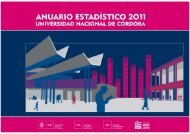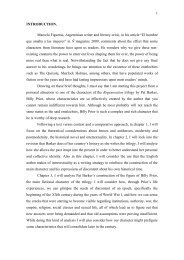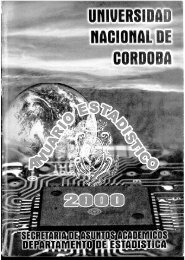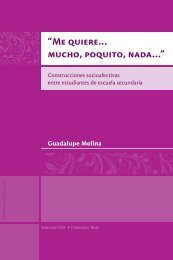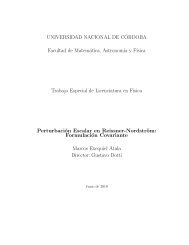Abrir - RDU - Universidad Nacional de Córdoba
Abrir - RDU - Universidad Nacional de Córdoba
Abrir - RDU - Universidad Nacional de Córdoba
You also want an ePaper? Increase the reach of your titles
YUMPU automatically turns print PDFs into web optimized ePapers that Google loves.
APÉNDICE 91<br />
A n :<br />
✟◦ ❍ + ❍❍❍❍<br />
◦ ✟✟✟✟✟ ◦ ◦ . . . ◦ ❍◦ B n :<br />
◦ + <br />
✏<br />
◦<br />
✏✏ ◦ . . . ◦ ◦ ◦<br />
C n : ◦<br />
+<br />
◦ . . . ◦ ◦ ◦<br />
E 6 :<br />
◦ + <br />
◦<br />
<br />
✏ ◦ ✏✏<br />
✏◦<br />
◦<br />
✏✏<br />
D n :<br />
◦ ◦ E 7 : ◦ ◦ ◦<br />
◦ + <br />
✏<br />
◦<br />
✏✏ ◦ . . . ◦ ◦ ✏✏ ✏◦<br />
◦<br />
◦<br />
◦<br />
◦ ◦ ◦ ◦ +<br />
E 8 : ◦<br />
+<br />
◦ ◦ ◦ ◦ ◦<br />
◦ ◦<br />
F 4 : ◦ ◦ ◦ ◦ ◦<br />
+<br />
G 2 : ◦ ◦ ◦<br />
+<br />
El siguiente teorema clasifica las subálgebras maximales regulares <strong>de</strong> las álgebras <strong>de</strong> Lie semisimples.<br />
Teorema A.1.2. [D1, Thm. 5.5] Sea g un álgebra <strong>de</strong> Lie semisimple, Φ su sistema <strong>de</strong> raíces,<br />
Π = {α 1 , . . . , α n } el conjunto <strong>de</strong> raíces simples, Π α el conjunto <strong>de</strong> raíces simples que se obtiene<br />
omitiendo α ∈ Π y δ la menor raíz en Φ con respecto a Π. Sea g(α) la subálgebra generada por<br />
los elementos e β , e −β con β ∈ Π α y e δ , e −δ ; y sea g[α] la subálgebra generada por los elementos<br />
e β , e −β con β ∈ Π α y α, e α . Entonces toda subálgebra g(α) con α ∈ Φ y toda subálgebra g[α] con<br />
α ∈ Φ excepto g es una subálgebra maximal regular <strong>de</strong> g. Más aún, toda subálgebra maximal regular<br />
es conjugada a una <strong>de</strong> estas subálgebras.<br />
Observación A.1.3. Las subálgebras g(α) dan todas las subálgebras semisimples maximales regulares<br />
<strong>de</strong> g y las subálgebras g[α] dan todas las subálgebras no semisimples maximales regulares<br />
<strong>de</strong> g. Más aún, estas últimas son parabólicas por construcción.<br />
Basándonos en el teorema y en los diagramas extendidos <strong>de</strong> Dynkin, enumeramos en la Tabla<br />
A.1 los tipos <strong>de</strong> subálgebras g(α) para toda álgebra <strong>de</strong> Lie simple tales que g(α) ≠ g, ver [D1, Tabla<br />
12]. Observar que las álgebras <strong>de</strong> tipo A n no poseen subálgebras regulares <strong>de</strong>l tipo g(α) propias. De<br />
esta tabla se sigue que toda subálgebra maximal regular semisimple verifica la <strong>de</strong>sigualdad (A.2).<br />
La primera columna <strong>de</strong>nota el tipo <strong>de</strong>l álgebra <strong>de</strong> Lie g, la segunda dim g, la tercera el tipo <strong>de</strong> la<br />
subálgebra g(α), la cuarta dim g(α) y la quinta dim g − rg g.<br />
Claramente, la ecuación (A.2) con m = g(α) se verifica para los casos excepcionales. Para los<br />
casos clásicos <strong>de</strong>bemos probar las <strong>de</strong>sigualda<strong>de</strong>s correspondientes. El caso B n se <strong>de</strong>duce inmediatamente<br />
<strong>de</strong>l caso C n , puesto que las <strong>de</strong>sigualda<strong>de</strong>s para n = 2 y n ≥ 2, k = n se verifican trivialmente.



